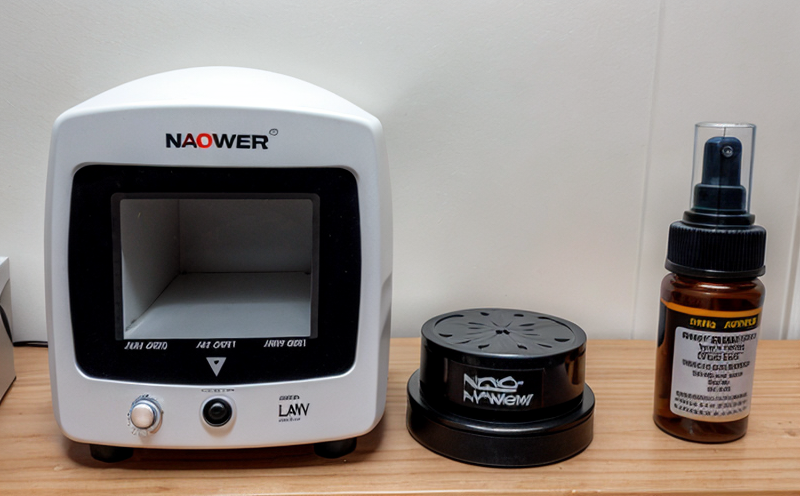Nanopowders & Particulates Testing
The testing of nanopowders and particulates is a critical component in ensuring the safety, efficacy, and reliability of nanomaterials used across various sectors. Nanoparticles possess unique properties that make them indispensable for applications ranging from electronics to pharmaceuticals. However, these same properties can also pose challenges when it comes to accurate measurement, characterization, and regulatory compliance.
Our laboratory specializes in providing comprehensive testing services tailored specifically to the needs of nanopowders and particulates. We use advanced analytical techniques that are capable of detecting even the smallest particles with precision and accuracy. This ensures that our clients receive reliable data which they can trust for decision-making purposes.
The importance of proper characterization cannot be overstated. Particle size distribution, shape, surface area, density, and agglomeration state are just a few parameters that need to be accurately determined during testing. These characteristics significantly influence the behavior of nanomaterials in different environments and applications. For instance, understanding how particles interact at interfaces or within complex systems is crucial for predicting their performance.
Our approach begins with thorough sample preparation which involves cleaning, dispersion, and stabilization processes designed to minimize artifacts and ensure accurate results. Once prepared, samples undergo a series of analyses using state-of-the-art equipment such as scanning electron microscopy (SEM), transmission electron microscopy (TEM), dynamic light scattering (DLS), and laser diffraction.
Dynamic light scattering is particularly useful for measuring particle size distributions over wide ranges. It provides information about both the hydrodynamic diameter and polydispersity index, which are essential parameters for assessing colloidal stability. Laser diffraction offers similar capabilities but extends down to smaller particles, making it suitable for ultrafine powders.
SEM and TEM provide high-resolution images that reveal detailed structural features of individual nanoparticles. These imaging techniques allow us to visualize particle morphology, identify impurities, and measure dimensions with sub-nanometer precision. Additionally, we can use energy-dispersive X-ray spectroscopy (EDS) integrated into our microscopes to determine elemental compositions.
The choice of analytical method depends on the specific requirements of each project. For example, if evaluating stability under certain conditions is required, then rheological measurements might be necessary alongside standard morphological assessments. Similarly, if bioavailability concerns exist, in vitro toxicity tests could form part of our comprehensive service offering.
Our team works closely with clients throughout all stages of the testing process, from initial consultation through final report delivery. By leveraging decades of experience combined with cutting-edge technology, we ensure that every test conducted meets or exceeds industry standards and regulations.
- Emissions reduction: By ensuring safer handling practices for hazardous materials, our testing helps minimize potential environmental impacts associated with improper disposal.
- Resource efficiency: Accurate characterization aids in optimizing production processes, leading to reduced waste generation during manufacturing stages.
- Sustainable design: Understanding the properties of nanomaterials enables more informed choices regarding sustainable product development and lifecycle management strategies.
In conclusion, nanopowders and particulates testing is not merely about meeting compliance requirements; it's an opportunity for innovation. With our expertise and commitment to quality, we strive to push boundaries while maintaining the highest standards of integrity and reliability.
Quality and Reliability Assurance
Ensuring high-quality outputs is paramount in any testing facility, especially when dealing with nanomaterials. The unique nature of these materials necessitates stringent quality control measures to ensure consistent results across multiple batches or samples.
We employ rigorous internal protocols designed specifically for nanopowders and particulates analysis. These include standardized operating procedures (SOPs) covering every aspect from sample receipt through final data interpretation. Our personnel undergo regular training programs focused on the latest technologies and methodologies relevant to this field.
Inter-laboratory comparisons play a vital role in maintaining reliability across our services. By participating in such exercises, we validate our methods against those used by other reputable institutions. This not only enhances credibility but also helps identify any discrepancies early on so corrective actions can be taken promptly.
Data accuracy is maintained through strict adherence to international standards like ISO 17025 and ASTM E1396. Compliance with these guidelines ensures that our findings are both reproducible and acceptable by regulatory bodies worldwide.
Furthermore, we maintain comprehensive documentation records for each completed test run. This includes raw data collected during analysis as well as interpretations made based on those readings. Such transparency fosters trust between us and our clients while also facilitating troubleshooting efforts should issues arise post-testing.
The commitment to excellence extends beyond technical proficiency into ethical considerations too. We adhere strictly to confidentiality agreements whenever handling proprietary information provided by our partners or customers. This ensures that sensitive data remains protected under all circumstances.
Frequently Asked Questions
Use Cases and Application Examples
The applications of nanopowders and particulates span numerous industries, each presenting unique challenges requiring tailored approaches. Here are some illustrative case studies:
- Battery Industry: Lithium-ion batteries rely heavily on nanoscale materials for improved energy density and faster charging capabilities. Testing focuses on optimizing particle size distributions to enhance performance while minimizing potential safety risks.
- Metallic Nanoparticles: Silver nanoparticles find extensive use in antimicrobial applications but require careful evaluation due to their toxicity potential. Our tests help manufacturers balance efficacy with safety standards.
- Pharmaceuticals: In drug delivery systems, precise control over nanoparticle dimensions is crucial for achieving targeted release profiles. We assist pharma companies by providing robust characterization data supporting formulation development efforts.
In each application area, our role revolves around ensuring that nanomaterials behave as expected under real-world conditions. Whether it's improving product performance or addressing regulatory compliance issues, our expertise contributes significantly towards achieving these goals efficiently and effectively.





